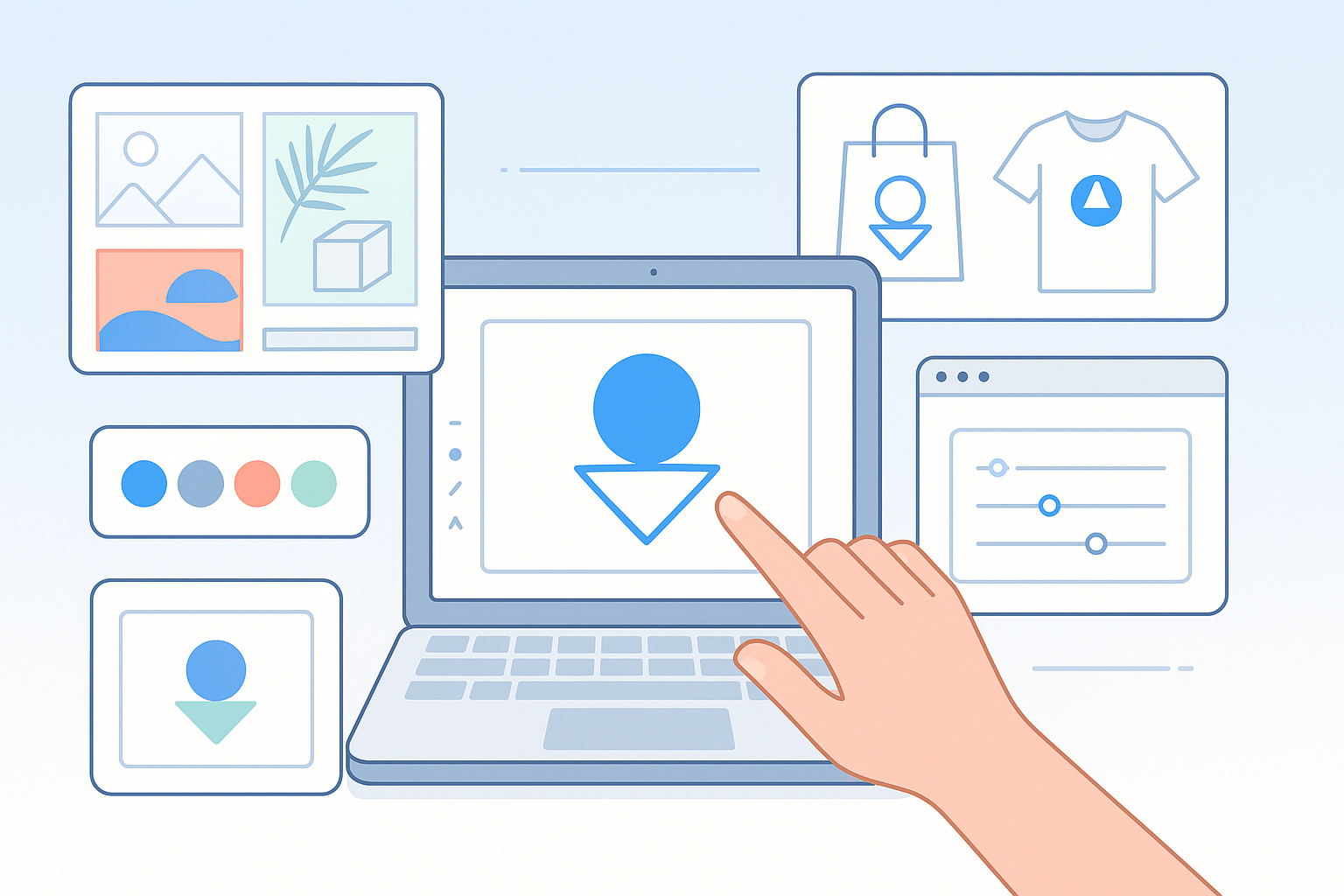
Branding has always fascinated me. After more than a decade of working in design and AI, I’ve seen businesses transform simply because they understood how to shape their visual identity. Branding isn’t just about creating a logo or picking a font. It’s about building a story, a connection, and a consistent look that customers remember. In this article, I’ll break down the tools I consider essential for creating and managing a strong brand identity today.
When I started helping small businesses with design, the process was time-consuming. Finding the right color palette, selecting fonts, and creating a logo could take weeks. Modern branding tools simplify this, enabling entrepreneurs to shape a brand in hours. But with so many options out there, choosing the right ones can be overwhelming. That’s why I’ve compiled a selection of tools that cover the key aspects of branding — from logo creation to brand management and analytics.
Logo Design Tools
The foundation of any brand is its logo. A well-designed logo acts like a visual handshake — the first impression your audience gets.
Turbologo: AI-Powered Logo Maker
One tool I know intimately is Turbologo. It was designed to help business owners create professional logos without hiring a designer. The AI engine generates multiple variations based on your preferences, and you can customize colors, fonts, and layouts until it feels right. The ability to create a logo with AI in minutes is what makes this tool stand out.
Expert Tip: When designing a logo, start with simple shapes and avoid unnecessary complexity. A logo should remain recognizable even in its smallest form.
Canva and Adobe Express
These platforms go beyond logo creation. Canva is particularly popular because of its drag-and-drop interface and a vast library of templates. Adobe Express (formerly Adobe Spark) offers similar features but with the design precision you’d expect from Adobe. I often recommend these tools to startups that need not just logos, but also social media graphics and marketing materials aligned with their brand identity.
Color Palette Generators

Colors evoke emotions and set the tone for a brand. Choosing the wrong palette can confuse customers or dilute your message.
Coolors and Adobe Color
Coolors is a tool I use when experimenting with fresh color combinations. It’s as simple as pressing the spacebar until you find a palette that clicks. Adobe Color, on the other hand, lets you analyze images to extract color schemes. I’ve often uploaded photos of nature or architecture to find inspiration for earthy or urban palettes.
Expert Tip: Stick to a palette with three to five core colors. Too many colors can make a brand look inconsistent.
Typography and Font Tools
Fonts speak louder than people realize. The wrong typeface can make a brand look unprofessional, while the right one builds trust.
Google Fonts and FontPair
Google Fonts is a treasure trove of free fonts optimized for web and print. When pairing fonts, I turn to FontPair — it suggests combinations that balance elegance and readability. Brands should pick one primary font for headings and another for body text to maintain a cohesive look.
WhatFont and Font Squirrel
WhatFont is a browser extension that helps identify fonts on websites. Font Squirrel, meanwhile, offers a curated collection of high-quality free fonts. These tools are ideal for businesses exploring different font styles without expensive licensing fees.
Brand Asset Management
After creating a logo and defining colors and fonts, the next challenge is managing all these elements. This is where brand asset tools step in.
Frontify and Brandfolder
Frontify is a platform I recommend to companies that want a centralized brand hub. It stores guidelines, logos, templates, and everything a marketing team needs. Brandfolder offers similar functionality with analytics features, allowing you to see how often certain assets are used. These tools are particularly useful when working with external teams or agencies.
Social Media Branding Tools
A brand is only as strong as its online presence. Consistency across social platforms builds trust and recognition.
Buffer and Hootsuite
Both Buffer and Hootsuite allow you to schedule posts, analyze engagement, and ensure your messaging stays aligned. I use these tools not just for posting but also for testing different visuals to see which resonates most with an audience.
Snappa and Crello
These are lightweight design tools that help create social media content fast. They come with templates optimized for various platforms — from Instagram Stories to LinkedIn banners.
Analytics and Feedback Tools
Building a brand is not just about creation, but also measurement. You need to know how people perceive your identity.
Brandwatch and Mention
Brandwatch analyzes brand mentions across social and web platforms. It’s invaluable for understanding how a brand is performing in real time. Mention offers similar features with a simpler interface, ideal for smaller teams.
Expert Tip: Pay close attention to sentiment analysis. Negative mentions provide insight into where your brand message might be failing.
AI Tools for Branding
AI is reshaping branding in ways that felt impossible a decade ago.
ChatGPT and MidJourney for Ideation
I’ve used AI-powered writing assistants like ChatGPT to brainstorm brand taglines or product names. MidJourney, on the other hand, is great for generating visual mood boards or concept art.
Create a Logo with AI
For businesses short on time, AI-driven logo makers like Turbologo are a game-changer. The process involves answering a few simple questions about the brand’s style and preferences. The AI then generates logo options, which can be refined until they match the desired aesthetic. This combination of speed and customization is why AI branding tools are gaining popularity.
Brand Collaboration Tools
Teams often struggle with keeping brand assets consistent across multiple campaigns. That’s why I emphasize collaboration platforms.
Notion and Trello
Notion doubles as a workspace and asset library. Trello, meanwhile, is excellent for managing content calendars and brand-related tasks. Both tools help ensure every project aligns with the brand’s voice and visuals.
Common Mistakes When Using Branding Tools
I’ve seen many businesses make the same errors:
- Overcomplicating designs — Too many fonts, colors, or elements can confuse customers.
- Ignoring brand consistency — Using different logos or mismatched tones across platforms weakens trust.
- Skipping feedback loops — A tool is only as good as the insights you gather. Always test brand assets with a small audience.
Case Example: From Concept to Brand Identity
One startup I worked with needed a visual identity within a week. We used Turbologo to generate a clean logo, paired it with a muted palette from Coolors, and finalized the typography via Google Fonts. Using Buffer, we rolled out social media posts within days. The result? A cohesive brand that looked like it had been planned for months.
How to Choose the Right Toolset
The best tool is the one that aligns with your goals. If you’re a solo entrepreneur, start with AI-based solutions like Turbologo or Canva. Larger teams should consider asset management tools like Frontify to maintain consistency across channels.
Expert Tip: Always test a tool with a small project before fully committing. What works for one brand might not fit another.
Frequently Asked Questions
What is the most important tool for branding?
A logo maker like Turbologo or Canva is a solid starting point. It gives you the visual foundation to build on.
Are free tools enough for branding?
Yes, especially for small businesses. Tools like Google Fonts and Coolors can deliver professional results when used thoughtfully.
How does AI change branding?
AI accelerates design processes, offering logo generation, tagline suggestions, and even full brand kits in minutes. It’s not about replacing creativity but enhancing it.
What’s the first step in creating a brand identity?
Define your brand’s core values and target audience. Then, use tools to visually translate those ideas into logos, colors, and fonts.
Raghav is a talented content writer with a passion to create informative and interesting articles. With a degree in English Literature, Raghav possesses an inquisitive mind and a thirst for learning. Raghav is a fact enthusiast who loves to unearth fascinating facts from a wide range of subjects. He firmly believes that learning is a lifelong journey and he is constantly seeking opportunities to increase his knowledge and discover new facts. So make sure to check out Raghav’s work for a wonderful reading.




